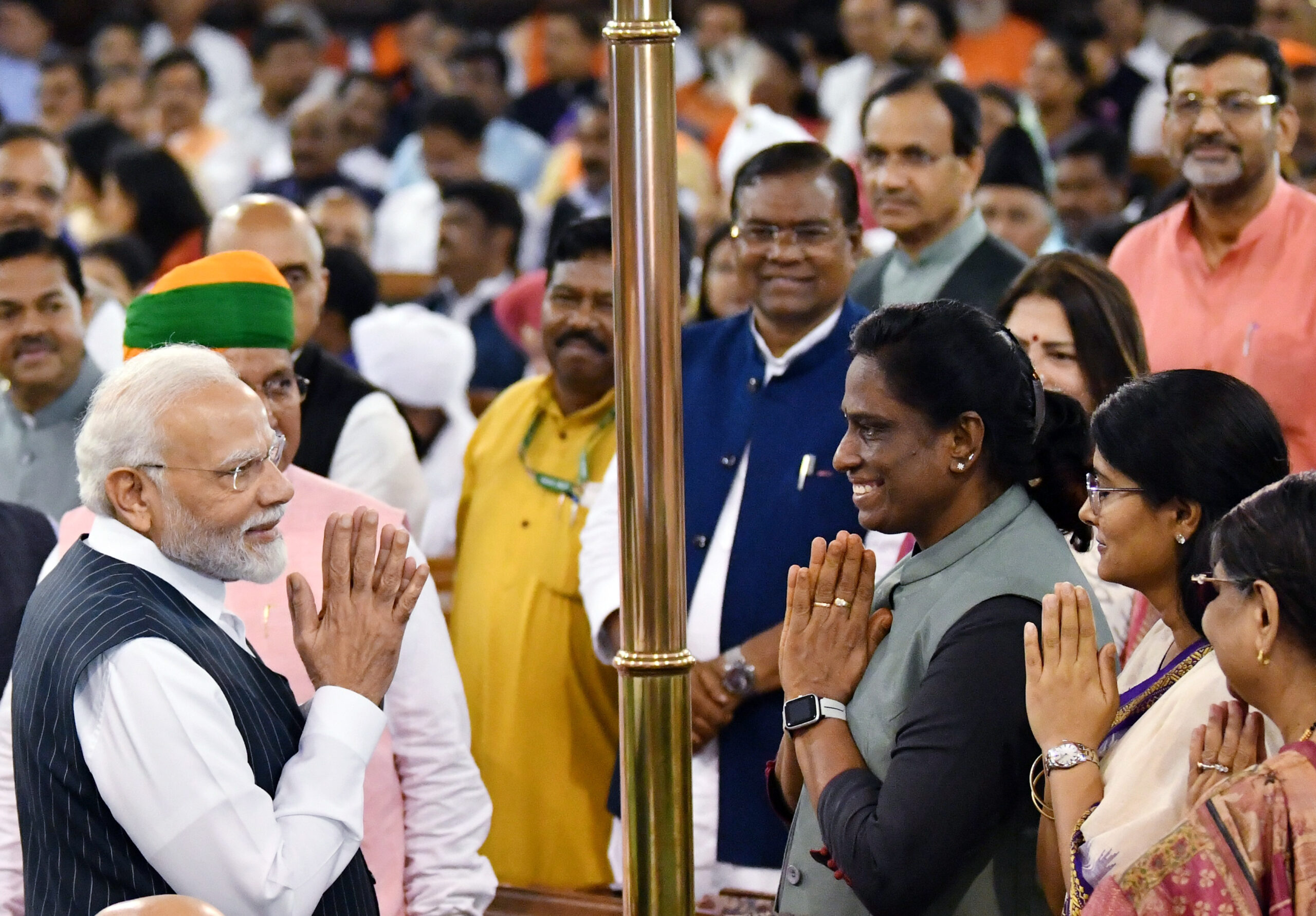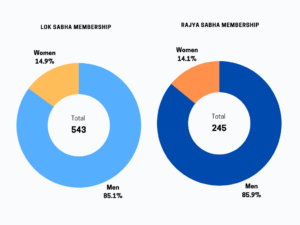
In a move set to have far-reaching impacts on India’s electoral politics, the Prime Minister Narendra Modi-led government introduced the 128th Constitutional Amendment Bill, 2023, during Tuesday’s special parliamentary session to bring in one-third or 33% reservation for women in the Lok Sabha and all state Legislative Assemblies. Named the “Nari Shakti Vandan Adhiniyam,” the bill was tabled in the Lower House by Union Law Minister Arjun Ram Meghwal amid uproar from the Opposition, which demanded “more clarity” about the quota.

The Union Cabinet had on Monday cleared the amendment bill—then known as the Women’s Reservation Bill (WRB)—and revived the amendment pending for almost 27 years due to the lack of consensus among various political parties. Tuesday’s proceedings made the Nari Shakti Vandan Adhiniyam the first piece of legislation to be introduced in the new Parliament building.
Now, with several parties pushing for reservations for women in both the Lok Sabha and state Assemblies, the bill is likely to see a smooth passage this time, unlike in the past when it was opposed by several regional parties for varied reasons. However, its implementation may take some time and it is unlikely to come into force for the 2024 Lok Sabha elections since the reservation will come into effect only after a delimitation exercise is completed.
WHAT IS THE BILL?
The Constitution (One Hundred and Twenty Eighth Amendment) Bill, 2023, seeks to introduce three new articles and one new clause in the Constitution. The first, 239AA says “Seats shall be reserved for women in the Delhi Legislative Assembly, 1/3rd of the seats reserved for SCs shall be reserved for women, 1/3rd of total number of seats to be filled by direct elections shall be reserved for women through law determined by parliament.” The new article, 330A reads, “Reservation for women in Lok Sabha – 1/3rd of seats reserved for SCs and STs shall be reserved for women, 1/3rd of total seats to be filled by direct elections to the Lok Sabha shall be reserved for women.” The second new article, 332A, states: “Reserved seats for women in every state Legislative Assembly, 1/3rd of seats reserved for SCs and STs shall be reserved for women, 1/3rd of total seats to be filled by direct elections to the LA shall be reserved for women.” Finally, article 334A mentions the following: “Reservation shall come into effect after the delimitation is undertaken after the relevant figures for the first census have been published. Rotation of seats for women shall take effect after each subsequent exercise of delimitation.”
HISTORY OF OPPOSITION
The bill, first introduced in 1996, has seen eight different governments trying to push for 33% reservation for women candidates in both Lok Sabha and state Assemblies. With Prime Minister Narendra Modi’s Union Cabinet clearing the bill, it now paves the way for the long-pending legislation to pass the test of parliament.
Inspired by a landmark law that allowed 33% reservation for women candidates at the panchayat level, the WRB was first introduced as the 81st Amendment Bill in Lok Sabha by then Prime Minister HD Deve Gowda and his United Front government in 1996. Many MPs sought its unanimous passage on the same day. However, leaders of the United Front coalition, including JD(U)’s Lalu Prasad Yadav and SP’s Mulayam Singh Yadav opposed the Bill.
It was then referred to a joint committee, headed by Communist Party of India’s (CPI) Geeta Mukherjee. The committee submitted a seven-point recommendation in December that year. However, the WRB lapsed after the dissolution of the Deve Gowda government.
A year later, Prime Minister IK Gujral’s government sought to pass the Bill but faced stiff opposition from within the ruling coalition. JDU’s then president Sharad Yadav infamously questioned whether “par-kati mahilaen” (short-haired, a euphemism for urban women) would be able to represent the causes of rural women. The WRB lapsed once again after the Congress withdrew support from the Gujral government. In 1998, the Atal Bihari Vajpayee-led National Democratic Alliance (NDA) government pushed the bill in the Lok Sabha and it was introduced in the Lok Sabha by AIADMK leader M Thambidurai, the then Minister of Law. However, the RJD’s Surendra Kumar Yadav, a key Opposition MP, snatched the papers from the then Speaker and tore them into bits. Accompanied by colleague Ajit Kumar Mehta, Yadav then dashed to the Speaker’s table to pick up more copies in an attempt to destroy them. Notably, the Vajpayee government attempted to introduce the Bill at least six times between 1998 and 2004.
Between 2008 and 2010, the Bill was introduced in Rajya Sabha and referred to the Standing Committee on Law and Justice. The Standing Committee presented its report and the bill was tabled in both Houses of Parliament amid protests by the SP, JD(U) and RJD. While the Women’s Reservation Bill was passed by the Rajya Sabha with an overwhelming majority in 2010, it was kept pending for four years and eventually expired.
VARYING STANCES
Over the years, the Congress buckled under pressure from its own leaders and MPs from the Other Backward Castes (OBCs)—these leaders often cut across gender and party lines and played leading roles in stalling the bill. Those opposing this reservation did so for a “quota within quota”.In 2010, the then Congress supremo, Sonia Gandhi, accepted that there were members in the Congress party because of whom the party “was not able to” get the requisite numbers for passing the WRB.
In the run-up to the special session, several parties, including the Bharat Rashtra Samithi and the Ajit Pawar faction of the Nationalist Congress Party pushed for the introduction of the Women’s Reservation Bill. When she was asked about the bill while she was entering Parliament on Tuesday, former Congress President Sonia Gandhi said, “It is ours, apna hai”.
The NDA has consistently held an unchanging stance through the years, supporting this legislation. Prime Minister Narendra Modi on Tuesday said the purpose of the new women’s reservation bill Narishakti Vandan Adhiniyam is to expand women’s participation in Lok Sabha and assemblies, and asserted it will further strengthen Indian democracy, as he urged MPs of both Houses of Parliament to pass the bill unanimously. “The Narishakti Vandan Adhiniyam will further strengthen our democracy. I congratulate mothers, sisters and daughters of the nation for Narishakti Vandan Adhiniyam. I assure all mothers, sisters and daughters of the nation that we are committed to making this bill into a law,” he said.
Key Details
Once the Bill becomes an Act, the law will be in force for 15 years and can be extended.
The number of women members in Lok Sabha will increase to 181 from 82.
Two amendments to bring in quota for the Anglo-Indian community included in the 2010 draft have been dropped.
It does not include reservation for OBCs, since this provision does not exist for legislature. This is why parties like the SP, RJD and JD(U) have opposed it since it was first introduced.
The quota will only come into effect after the first delimitation or redrawing of constituencies once it becomes law.
Delimitation will occur based on the first Census taken after 2026-originally 2031.
The last Census was meant to be held in 2021 but was delayed due to Covid-19, so the next count might be in 2027.